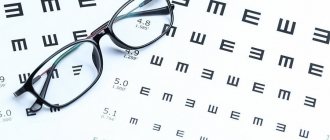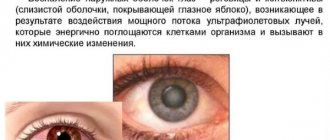What are contact lenses? This is one of the modern methods of vision correction. The lens is installed on the cornea of the eye and, depending on the optical power, increases or decreases the refraction of rays passing through it. For farsightedness, “plus” contact lenses help shift the main focus to the retina.
Types of contact lenses for farsightedness
There are two types of CL used to treat farsightedness: hard and soft. Rigid contact lenses are not used to correct isolated hypermetropia. Such lenses are suitable for correcting farsightedness in combination with lesions of the anterior segment of the eye, in particular the cornea (for example, with keratoconus).
Soft contact lenses (SCLs) are mainly used to correct hypermetropia. Modern materials are used in the production of SCLs. There are silicone hydrogel and hydrogel SCLs.
Hydrogel SCLs contain a large amount of water. This makes them softer than silicone hydrogels. Such SCLs require daily replacement due to their low strength. Silicone hydrogel SCLs contain less moisture, but have greater oxygen permeability. An ophthalmologist determines which lenses a patient should choose.
Where to buy lenses to correct farsightedness?
If you have a prescription in hand or you know exactly what lenses you need, you can buy them in any salon or online store. You will find a large selection of ophthalmic products for the correction of hypermetropia and presbyopia on the Ochkov.Net website. Among lenses with multifocal design, Oasys for Presbyopia, Biofinity Multifocal, Proclear Multifocal are in great demand. If you need aspherical lenses, pay attention to the following models: monthly Air Optix Aqua, daily Dailies AquaComfort Plus and Proclear 1 Day and color Adria Glamorous.
In our store you can not only buy optics, but also find out answers to many important questions: how to use lenses correctly, care for them, what solutions are best to purchase, etc.
Wearing mode and frequency of lens replacement
Based on the time of use, all soft contact lenses for farsightedness are divided into:
- one-day;
- scheduled replacement (change once a week, once a month);
- traditional (requires replacement every 3, 6 or 12 months).
Ophthalmologists around the world prefer daily CL. Such SCLs are the safest and do not require maintenance. Complications in the form of keratitis and conjunctivitis practically do not occur. The disadvantage of one-day SCLs for farsightedness is their high cost.
Depending on the wearing mode, CLs are distinguished:
- daily wear (no more than 24 hours);
- prolonged wearing (worn without removing for 1 week);
- long-term wearing (can not be removed for 1 month).
It should be remembered that the longer the CL is on the eye, the higher the risk of corneal damage due to lack of oxygen, trauma, and infection.
Types of lenses and their use for hypermetropia
To correct the vision of patients with hyperopia, contact lenses are used, which have virtually no effect on the quality of life. The CL should be prescribed by an ophthalmologist, taking into account the radius of curvature, diameter and optical power.
The main advantage of optics for farsightedness is psychological comfort. Patients want to hide their vision problems from others. CL will help with this, since they are not noticeable when worn.
Multifocal
Manufacturers offer two types of optical devices—intraocular and contact.
The first are implants installed in place of the lens that has lost its strength. The second ones are artificial. Multifocal lenses for hyperopia help to read and write. They have a number of positive aspects that glasses do not have.
Pros:
- convenient to play sports, ski;
- do not cause discomfort;
- no distortion;
- Some models can be worn for up to 1 week without taking them off before bed.
Multifocal lenses have several zones where the optical power changes. This creates clarity of vision.
Bifocal
They contribute to picture clarity at any distance of the object, because a pair of optical zones with different refractive powers work. They have two focuses - for distance and near. The positive one is located at the bottom, the negative one is at the top.
Bifocal lenses allow you to read, work on a computer and play sports. They replace two pairs of glasses with one.
Circular
This type is universal for hypermetropia. The center of far refraction alternates with the near one. The central nervous system independently selects the necessary projection.
Aspherical
With their help, farsightedness is corrected to a moderate degree. The central part is responsible for close distances, and the periphery for long distances.
Aspherics are convenient to use because their shape is close to the natural state of the eye. Focusing of vision occurs faster, even if the user looked at a nearby object for a long time and moved his gaze to the one that is further away.
"Monovision"
This correction method is performed using spherical lenses of different diopters. One allows you to see objects up close, the other - at a distance.
Spherical lenses are not convenient for hypermetropia, since a person has to look at an object with one eye, depending on the distance at which it is located.
Contraindications to wearing SCLs for farsightedness
Contraindications to wearing contact lenses for farsightedness are divided into temporary and permanent. Temporary contraindications include any infectious lesions of the anterior part of the eye - conjunctivitis, keratitis, acute blepharitis, dacryocystitis. After recovery, the doctor will determine whether it is possible to wear SCL.
Permanent contraindications include:
- ptosis of the upper eyelid;
- severe dry eye syndrome;
- severe strabismus;
- corneal scars;
- glaucoma with a significant increase in intraocular pressure.
Features of laser vision correction
Farsightedness is a refractive error where the image is focused outside the retina. A similar defect occurs in people with short eyeballs and visual axes. With farsightedness, a person is able to clearly see objects in the distance, but has trouble making out small details up close.
Correcting farsightedness using a laser is considered the most effective treatment method. If just a few years ago the operation was a cause for concern, today the technology has been perfected and tested by thousands of patients.
This method can quickly correct hypermetropia up to 5 diopters in patients 18-50 years old. The operation also allows you to get rid of farsightedness, complicated by astigmatism within ±3 diopters.
For which diseases laser correction cannot be performed:
- glaucoma;
- cataract;
- keratoconus;
- lens spasm;
- inflammatory processes in the eyes;
- progressive visual impairment;
- diabetes;
- having only one eye;
- arthritis;
- retinal disinsertion;
- vascular pathologies;
- weakened immunity.
There are LASIK and PRK methods. The first is the most accurate and safe, and the second is an alternative if there are contraindications to LASIK surgery. The Super-LASIK technique is considered the most progressive and effective.
What is better to use for farsightedness - lenses or glasses?
Contact lenses for farsightedness, unlike glasses, do not limit the patient’s field of vision; vision correction is carried out both in the central zone and in the periphery.
SCLs are not visible to others; it is almost impossible to notice CLs on the cornea without looking closely. This is important, for example, for children with farsightedness. Schoolchildren are sometimes embarrassed to wear glasses, but CLs help correct vision and are not visible to others. In old age, when vision decreases, it is also psychologically difficult for a person to start using glasses. The need to wear CLs is perceived better by such patients.
Eye with contact lens
With SCLs, you can engage in any type of sports activity, except those where there is a risk of water getting on the lenses. They will not fall out of the eye and will not be damaged. Storage of SCLs is more convenient compared to glasses. The container for CL is small and difficult to damage. The CL material does not fog up when the room temperature changes. Unlike glasses, they are comfortable to wear at any time of the year and in any weather conditions.
The disadvantages of SCLs include the need for daily care (except for one-day CLs) and a greater likelihood of developing infectious and degenerative complications compared to glasses.
The most popular artificial lenses
Multifocal lenses. The special design of such lenses allows you to imitate the work of the natural lens of the eye and achieve optimal visual acuity both near and far, significantly reducing a person’s dependence on glasses or eliminating them altogether. Implantation of a multifocal intraocular lens becomes a real salvation for patients with presbyopia (age-related farsightedness). With age-related farsightedness, it becomes difficult for a person to distinguish small objects close up, read newspaper font, work with small details, etc. This is due to the fact that with age-related farsightedness, the lens of the eye gradually becomes denser, weakness of the ciliary muscle appears, and the reserves of the accommodative ability of the eye decrease. All this ultimately leads to vision deterioration. Implantation of a multifocal lens makes it possible to compensate for lost accommodation and provides visual adaptation at various distances. According to clinical studies, 80% of patients who were implanted with a multifocal lens do not use glasses or contact lenses.
Lenses with a special yellow filter , which in its properties is similar to the filter of the natural human lens. It protects the retina from the harmful effects of ultraviolet and blue rays and reduces the risk of developing age-related retinal diseases.
Aspherical lenses with an aspherical surface and a yellow filter. In addition to protecting the retina from the harmful effects of ultraviolet and blue rays, it provides clearer and more contrasting vision in the evening. Which is indispensable, for example, for drivers.
How are MCLs selected?
An ophthalmologist will tell you how to choose the right contact lenses for farsightedness. Only he has the right to determine what lenses the patient needs. At the first stage, a vision test with trial correction and autorefractometry is carried out. The doctor checks for the presence of concomitant diseases by checking the value of intraocular pressure and performing a fundus examination on a wide pupil.
Read in a separate article: Is it possible to wear contact lenses with astigmatism: selection rules
CLs are selected taking into account the most complete correction tolerated by the patient. A special device is used to determine the basic parameters of the patient’s eye, necessary for the correct selection of CL. These include the curvature and diameter of the cornea.
After the studies, the ophthalmologist selects a trial CL for the patient and installs it on the eye. Visual acuity in the lens is checked. The patient removes the trial CL after a few hours. If the wearing was comfortable, dizziness or distortion of objects did not appear, the doctor writes a prescription for CL with the necessary parameters and the wearing mode desired for the patient and the timing of replacement.
Rules for using and storing lenses
Before placing the lens on your eye, you should thoroughly wash your hands with soap and dry them. The CL is removed from the blister (bottle, container) with clean hands and placed on the index finger. With the other hand, you need to pull the lower eyelid down. Using your index finger, the lens is installed on the cornea of the eye, after which you need to make several blinking movements. A correctly installed CL is not felt on the eye. The same is repeated with the other eye. After putting on the lenses, the container in which they are stored must be washed with warm water and soap and left to dry open.
In order to remove the contact lens, you need to move it down with your index finger, and then remove it from the eye with two fingers. The removed lenses are placed in a container with a new special solution for SCL. Modern solutions are universal - they are used to clean, store and disinfect SCLs. The solution in the container should ideally be changed every day, even if the contact lenses themselves are temporarily not used.
For long-term wear of SCLs, enzyme cleaners in the form of tablets are additionally used. These substances remove protein deposits from the surface of the CL.
We invite you to watch a detailed video about the rules for using and caring for contact lenses:
Correction of farsightedness
When choosing a treatment method, the ophthalmologist first conducts an examination to find out the causes of the disease , type of activity, concomitant diseases, and age.
Modern clinics can offer patients optical vision correction or surgical intervention.
Not everyone wants to wear glasses, so the doctor gives the opportunity to use contact lenses, most often multifocal , since with their help you can see objects near and far equally well. A foreign body in the eye can exist comfortably if properly cared for.
If the patient previously had several types of glasses, then after purchasing contact lenses this problem will disappear. You can stay in them around the clock, go to work, play sports, drive a car, sleep. An ophthalmologist resorts to surgery as a last resort, in severe cases of illness, when other methods are powerless. There are also restrictions on age; operations can be performed on people over 18 years of age.
Using SCL for age-related farsightedness
Age-related farsightedness (presbyopia) is characterized by changes in the lens associated with a decrease in its elasticity. The lens stops refracting rays correctly, and as a result, a person’s ability to clearly see objects located at a close distance deteriorates. Presbyopia is often combined with other refractive errors - farsightedness and myopia.
To correct presbyopia, special multifocal CLs are used - for farsightedness and myopia at the same time. The central part of such a lens is designed for working at close range. The optical power of the central part is equal to the optical power of the glasses for farsightedness in this patient. The peripheral region is designed to maintain high visual acuity when looking into the distance. That is, if the patient has isolated presbyopia, this part of the SCL will be “empty” (without diopters). If presbyopia is combined with farsightedness or nearsightedness, this area will have a corresponding refraction.
Multifocal CLs do not differ in appearance from regular ones. The mode of wearing and timing of replacement depend on the manufacturer.
What is farsightedness? Features of the pathology
This visual defect, otherwise called hypermetropia, is characterized by the fact that a person sees any objects relatively well at a certain distance, but distinguishes them very poorly up close. The eyes simply cannot focus on objects located close enough, which creates certain difficulties . Although in some cases, when farsightedness is high, a person is unable to normally distinguish objects even at a distance. You should not think that a person with such a pathology will see something far away perfectly.
Normal vision and farsighted vision
It is quite difficult for those suffering from this disease to perform a number of ordinary activities - reading, writing, doing some simple minor work. Plus, eyes with such a defect are overstrained and more tired during the day, which in addition causes headaches.
Why is farsightedness dangerous?
The main cause of hypermetropia is a change in the size of the eye . The defect is also observed when the refractive power of the organ of vision is insufficient, when the rays are focused not on the retina, where they should, but behind it. As a result, the visible image becomes blurry and indistinct.
Farsightedness (hypermetropia)
On a note! Farsightedness can be normal, or it can be associated with aging of the body. This is the so-called age-related farsightedness, called presbyopia. In both cases, the defect is easy to correct.
Table. Degrees of hypermetropia.
| Degree | Value, dioptres |
| I | Up to 2 |
| II | Up to 4 |
| III | More than 4 |
We are talking about an eye disease called farsightedness.
Complications
Complications when using SCLs arise when the terms and conditions of wearing, storage conditions, or damage to the surface or edge of the lens are violated.
If an infectious eye disease develops, the contact lenses are removed and disposed of. Such CLs cannot be reused, regardless of the remaining shelf life.
To prevent corneal dystrophy and dry eye syndrome, it is necessary to use special moisturizers in the form of drops or gels. Conventional medications should be instilled 15 minutes before putting on the SCL or after removing it. Special preservative-free forms (BC) can be used with a lens installed on the eye. If there is severe discomfort or dry eyes, it is recommended to switch to daily SCLs, as they have a higher moisture content and greater oxygen permeability. Patients note in their reviews that such lenses are more comfortable for the eyes compared to long-term wear SCLs.
Author of the article: Tatyana, specialist for the website glazalik.ru Share your experience and opinion in the comments.









